
Here is a social media microblog-sized post just to say we are syndicating to social.coop Mastodon and Twitter thanks to the Indieweb module!
It's great to be here, and there, and there.

Create and use a custom permission in your module
You can define your own permissions for the Drupal permissions page (/admin/people/permissions in modern Drupal, Drupal 8, 9, 10, and beyond) and then add conditional options to your code to do different things based on the role of the user and the permissions configured by a site administrator. See how!
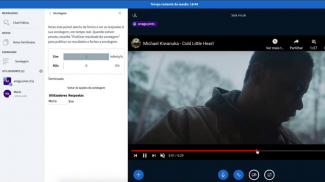
Why we resist Zoom and choose BigBlueButton for video chat
We can look at the recent popularity of some widely used platforms like Zoom and ask ourselves some questions as to why we still use them when we know a lot of terrible things about them. Agaric prefers to use a free/libre video chat software called BigBlueButton for many reasons, the first one being the licensing, but there are many reasons.

Drupal toolbar not working in dev environments in Firefox? Here's why.
Drupal's toolbar not showing due to Uncaught DOMException quota has been exceeded may be due to sites sharing a top-level domain (default for some local development environments like DDEV) combined with a Firefox bug.

Upgrade from Drupal 6 or 7 when it is right for you: In the era of modern Drupal, release cycles of major versions have only minor importance
Drupal 7 has a much longer lifespan than the (already pushed back) official date, and Drupal 8 has an essentially infinite lifespan because it can update in-place to Drupal 9 easily and the same will be true of Drupal 10, 11, ∞. There's no reason to rush an upgrade— but there's no reason to wait either.
Community-managed categories
A long-held goal, this functionality still hasn't been built. But if you're interested, please contact us! Community-managed taxonomy opens categorization of content to the site's community. Users can influence both what terms nodes are tagged with and how these terms are themselves organized.

Double-edged Raiser: Past time to ditch Blackbaud
I have watched in sadness and sometimes anger as large non-profit after large non-profit collectively poured enough money into Raiser's Edge and other Blackbaud licenses and consulting services to fund massive feature enhancements for the main FLOSS alternative, CiviCRM— improvements which would then be free for everyone, forever.
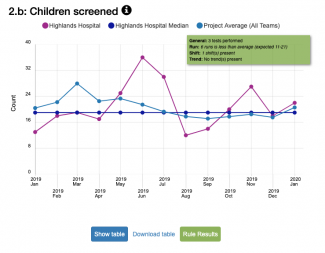
Are you building communities of practice for community health in this time of public recognition of injustice?
The struggle to take seriously the impact of racism on public health during the covid-19 crisis spotlights the importance of health communities of practice and their need to have high-quality, data-driven discussions. How do we have and expand these conversations well?
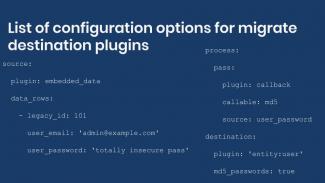
Drupal migrations reference: List of configuration options for destination plugins
In the previous article we provided a reference of available configuration options for migrate source plugins. In today’s article we are doing something similar for destination plugins. We will present a reference of available configuration options for migrate destination plugins provided by Drupal core and some contributed modules. Knowing which options are available might require some Drupal development knowledge. By providing this reference it should make the process of writing migrations easier.
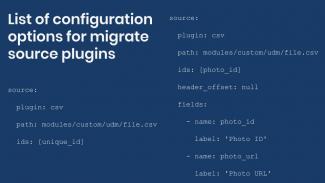
Drupal migrations reference: List of configuration options for source plugins
In a previous article we explained the syntax used to write Drupal migration. We also provided references of subfields and content entities' properties including those provided by the Commerce module. This time we are going to list the configuration options of many migrate source plugins. For example, when importing from a JSON file you need to specify which data fetcher and parser to use. In the case of CSV migrations, the source plugin configuration changes depending on the presence of a headers row. Finding out which options are available might require some Drupal development knowledge.
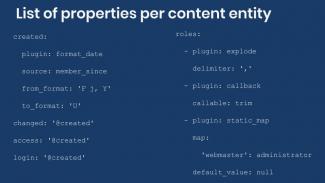
Drupal migrations reference: List of properties per content entity
In a previous article we explained the syntax used to write Drupal migrations. When migrating into content entities, these define several properties that can be included in the process section to populate their values. For example, when importing nodes you can specify the title, publication status, creation date, etc. In the case of users, you can set the username, password, timezone, etc. Finding out which properties are available for an entity might require some Drupal development knowledge.
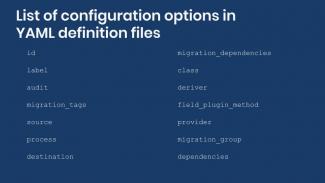
Drupal migrations reference: List of configuration options in YAML definition files
In today’s article we are going to provide a reference of all configuration options that can be set in migration definition files. Additional configuration options available for migrations defined as configuration will also be listed. Finally, we present the configuration options for migrations groups.

Free Drupal 9 webinars on site building, migrations, and upgrades
On Tuesday, July 7, Agaric will host 3 free online webinars about Drupal 9. We invite the community to join us to learn more about the latest version of our favorite CMS. We will leave time at the end of each presentation for questions from the audience. All webinars will be presented online via Zoom. Fill out the form at the end of the post to reserve your seat. We look forward to seeing you.

Show and Tell con Agaric - Compartir el Trabajo con Otras Cooperativas
Agaric hosts a weekly Show and Tell to share tips and tricks, but this week we had a presentation on how cooperative developers can share work on projects.

Online trainings on Drupal migration and upgrades
Agaric is excited to announce online training on Drupal migrations and upgrades. In July 2020, we will offer three trainings: Drupal 8/9 content migrations, Upgrading to Drupal 8/9 using the Migrate API, and Getting started with Drupal 9.

Keep modules compatible with multiple Drupal Core branches while using new services
How to keep modules compatible with Drupal 8.7 and below while still using the new services.
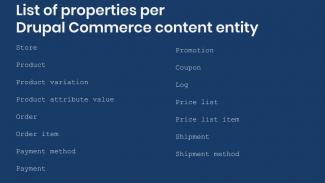
Drupal migrations reference: List of properties per Commerce content entity
In today’s article, we are presenting a reference of properties available in content entities provided by Drupal Commerce and some related contributed modules.

Going online together to save our lives
We, as a society, expected going online would lead to mass democratization and access to information that empowers large groups of people. Instead, we got outsourced.
Pagination
- Previous page
- Page 2
- Next page

